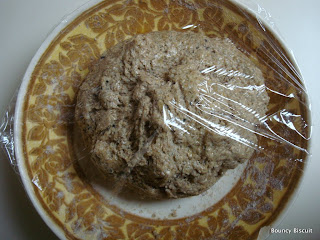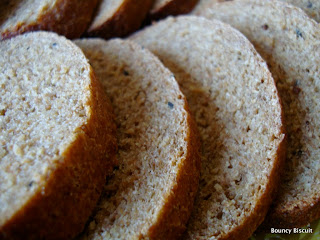Recipe: Buttermilk rye bread (make 1 loaf)
Ingredients:
- 2 cups Hodgeson Mill stone ground rye flour
- 1 cup King Arthur bread flour
- 2+1/2 tps active dry yeast
- 1 TB vital gluten powder
- 1 tp black caraway seeds
- 2 tp kosher salt
- 4 TB buttermilk powder
- 2 TB molasses unsulphured
- 2 TB olive oil
- 1+1/4 to 1+1/2 cup water
Procedure:
1. Proof yeast in 1/2 cup warm water.
2. Mix rye flour, bread flour, gluten, caraway seeds, salt, and buttermilk powder in a large bowl. Mix thoroughly.
3. Add proofed yeast the 1/2 cup water into the flour mixture. Mix lightly.
4. Add water, 1/4 cup at a time, to the mixture while stirring.
5. After adding in total 1 cup of water (including the amount used to proof yeast), add molasses.
6. Mix well. Continue mixing and adding water until the mixture has hydrated comfortably.
7. Observe the formation of gluten and the texture of the dough while mixing.
8. When dough is done, rub top lightly with oil. Cover with plastic wrap. Chill overnight.
9. Shape dough into a log and rub the top with olive oil. Return dough to the bowl and place in refrigerator to chill for up to 2 more days, until 4-6 hours before baking.
10. On the baking day, place the log in a greased pan to warm up, allowing 2-4 hours for the rise to take place. Dough should rise substantially, though may not rise enough to double its volume. Dough show some small sign of deflation after 2 hours.
10. Preheat oven to 375F. Bake loaf for 15-20 minutes. Then cover top with foil and continue baking at 350F for 20-25 minutes (up to 40 minutes), until internal temperature reaches 190F.
11. Turn loaf out to cool on rack before slicing.
Results:
Day 1
Day 1, 11:11pm, mixture of dry ingredients:
Day 1, 11:16pm, mixture with 1/2 cup of warm water and proofed yeast:
Day 1, 11:20pm, mixture with 1 cup of warm water:
Day 1, 11:23pm, 2 TB molasses added:
Day 1, 11:31pm, 1/4 cup of warm water added:
Day 1, 11:35pm, kneading continued:

Day 1, 11:42pm, dough formed:
Day 1, 11:42pm, dough's texture:
Day 1, 11:47pm, dough oiled and wrapped to chill:
Day 2
Day 2, 6:42pm, dough chilled overnight, expanded in volume:
Day 2, 6:43pm, dough's stickiness and the development of gluten:
Day 2, 6:46pm, dough shaped while cold; observe how it does not stick to the hand:
Day 2, 6:46pm, close-up look on dough's surface:
Day 2, 6:49pm, dough oiled again to be chilled:
Day 2, 6:49pm, dough ready to continue chilling:
Day 3
Day 3, 12:10pm, dough taken out of fridge to warm on counter; observe the expansion of dough while chilling:
Day 3, 12:13pm, dough placed into greased pan to rise; minimal handling is done to transfer dough from bowl to pan:
Day 3, 12:13pm, dough's height at the start of the rise:
Day 3, 2:39pm, dough risen for 2+1/2 hours:
Day 3, 3:32pm, dough risen for 3 hours:
Day 3, 3:32pm, dough's height after rising 3 hours:
Day 3, 3:39pm, final touch, brushing dough with water before baking:
Day 3, 3:39pm, dough's height just before baking:
Day 3, 3:59pm, loaf baked 20 minutes at 375F:
Day 3, 4:00pm, loaf returned to oven covered to resume baking at 350F:
Day 3, 4:35pm, loaf baked 35 minutes at 350F, internal temperature reaching 190F:
Day 3, 4:36pm, thermometer coming out sticky:
Day 3, 4:43pm, loaf baked another 7 minutes.
Day 3, 4:43pm, loaf's height:
Day 3, 4:44pm, loaf's bottom:
Day 3, 4:45pm, loaf's heel:
Day 3, 4:45pm, loaf's side:
Day 3, 4:45pm, loaf's top:

Day 3, 6:11pm, loaf cooled and yielded 16 dense slices:
Day 3, 6:11pm, an end-of-loaf slice:
Day 3, 6:12pm, a center-of-loaf slice:
Day 3, 6:14pm, crust and crumb of the rye loaf:
Day 3, 6:27pm, a bite:
This bread is so rich in its flavor... it deserves the full attention of one's palate.
Observations:
1. This is an adaptation of Bernard Clayton's original recipe of buttermilk rye-whole wheat bread, which has the following ingredients:
- 1 cup rye flour
- 1 cup whole wheat flour
- 1 package dry yeast
- 1 TB wheat germ
- 1 TB caraway seeds
- 2 tps salt
- 1 cup buttermilk
- 3 TBs molasses
- 2 TBs vegetable oil
- 1 cup bread flour
2. This time I am trying to make sure that the dough has sufficient gluten. So I use bread flour and gluten. I also use 2/3 rye flour and 1/3 bread flour, with 1 TB gluten.
3. I allow the dough to chill overnight and see how it will turn out.
4. On day 2, the dough has distinctively grown in the fridge. Its texture is really hard and sticky, even though I can see gluten developed. The flavor of the dough is really yummy though.
5. The loaf continues to expand in the fridge throughout the second night of chilling.
6. This loaf remains dense and cold throughout the 3 hour of warming time. It is possible that I have simply not given the dough ample time to rise after taking it out of the fridge. Perhaps some heat could have helped the dough to rise during the warm up time, or I could give it one whole day to rise.
7. Even though the loaf is so dense, its taste is superb! It has the very rich and complex flavor that comes from the mix of molasses, black caraway seeds and the acidic fermented rye. Truly a loaf for the highly refined palate.
Eventually it prompts me to ask the question of whether it really makes sense to use rye flour to make sandwich loaf and expect it to yield something soft and high-rising like whole wheat sandwich loaf. Perhaps I should give it more tries before giving up.
This is a tribute to Dough for his constant support of our food research!








































No comments:
Post a Comment